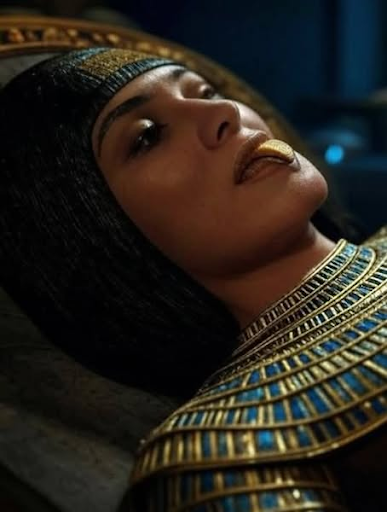 The Golden-Tongued Mummy was discovered in the temple of Taposiris Magna, west of Alexandria, in early 2021, by a Doctor searching for the lost tomb of Cleopatra. It was discovered by a team of Egyptian and Dominican archaeologists led by Kathleen Martínez.
The Golden-Tongued Mummy was discovered in the temple of Taposiris Magna, west of Alexandria, in early 2021, by a Doctor searching for the lost tomb of Cleopatra. It was discovered by a team of Egyptian and Dominican archaeologists led by Kathleen Martínez.The mummy belongs to a woman, and the style of burial and artifacts surrounding the burial of this woman indicate that she was buried during a period when Egyptian and Greco-Roman cultural influences blended, creating a period when traditional Egyptian burial customs were practiced alongside Greek and Roman influences. Therefore, it is thought that he lived during the Ptolemaic - Greco-Roman Period. Archaeologists have not been able to determine his name, status or cause of death due to the poor state of preservation. However, the presence of the golden tongue indicates that he may have been an important person and, at the very least, someone connected with wealth and capable of an elaborate funeral. Considering that the burial ceremony was at the site of a temple of significant religious and political significance, this may mean that the woman was a nun or had a connection with the temple, but it is not yet known and is only an educated guess. Why did he have a golden tongue? In Egyptian religious texts, the gods are described as having golden skin, silver bones and lapis lazuli hair. Many temple reliefs and sculptures depict gods with golden-toned bodies, emphasizing their divine nature. Unlike other metals, gold does not rust and deteriorate over time. The Egyptians saw it as a symbol of the immortality and divine essence of the gods. This belief influenced burial customs. As it is known, the ancient Egyptians believed in preparing the dead for the hereafter. The golden tongue amulet or foil was therefore most likely placed in the mummy's mouth, especially with the gods of the Underworld, especially the god Osiris, the ruler of the Underworld. The golden tongue, therefore, will adorn his speech and allow him to speak with a "golden" and divine confidence in the judgment of his soul, protecting him with a safe passage to the celestial realm known to the Egyptians as the "Reed Field" and allowing him to speak with a "golden" and divine confidence.



No comments:
Post a Comment